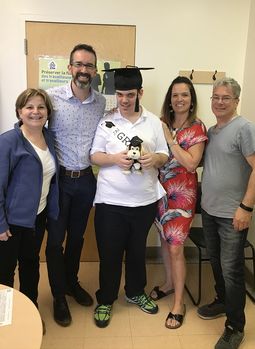
Jennifer Damiani, mother of Gabriel Damiani-Boivin; Dr. Philippe Major, pediatric neurologist at CHU Sainte-Justine; Gabriel Damiani-Boivin, patient; Lucie Côté, nurse at CHU Sainte-Justine; and Stéphane Boivin, father of Gabriel Damiani-Boivin
Credit: CHU Sainte-Justine
Faced with a severe lack of resources to provide a transfer of care adapted to young people with complex epilepsy, three professors from the Department of Neurosciences at UdeM, Dr. Mark Keezer, Dr. Philippe Major and Dr. Dang Nguyen, have developed a new transition model between the CHU Sainte-Justine and the CHUM.
The creation of this innovative program, entitled "Transition en épilepsie complexe de l'Université de Montréal (TÉCUM)," is supported by a one-time donation of $1 million from TD Bank Group. This is the first step in establishing this unique initiative in Quebec.
"Drs. Keezer, Major and Nguyen are the leading trio in epilepsy research. Their project, generously supported by TD, aligns with the core mission of the Université de Montréal, which is to transform lives and work in service of the common good." ─ Daniel Jutras, Rector of UdeM
"I'm delighted that the teams at the CHUM and the CHU Sainte-Justine will work together. This close collaboration is the key to success for a project of this scale. TD's donation will act as a lever with funding agencies to implement the research and knowledge creation component of the TÉCUM program." ─ Dr. Patrick Cossette, Dean of the Faculty of Medicine at UdeM and a specialist in epilepsy
"Through the Better Health component of the TD Ready Commitment, we are making a promise to continue investing in research, technology and innovative solutions aimed at promoting more equitable access to care for everyone. The program to transition children with epilepsy into adult care will undoubtedly help these young people, who must cope with the disease every day, look to the future with confidence," said Sylvie Demers, , President, Quebec Region, TD Bank Group.
Providing the missing link
Nearly 600 children with refractory epilepsy, i.e., resistant to standard medications, are currently being treated at the CHU Sainte-Justine. Of this number, 80 suffer from tuberous sclerosis, an inherited disorder that causes widespread damage, especially to the brain and vital organs.
At age 18, these young patients must be transferred from pediatric care to adult care at the CHUM. Currently, there is no transition program for epilepsy which ensures that the medical and psychosocial needs of patients and their families are properly managed. The transfer often boils down to a simple medical note. Loss of follow-up, risk of complications, an increase in seizures... these are the hazards that await young people with epilepsy at this crucial stage of their lives, due to a process that lacks planning and coordination.
Transitioning from one hospital to another is a huge source of stress and apprehension for young people, who are being asked to assume more responsibility for managing their illness. This is often experienced as a rupture for patients and their families, as well as healthcare teams.
"I was under the impression that that at age 18, my son would see the doors of Sainte-Justine Hospital close on him and we would be left on our own. Here we benefit from very close follow-up. So of course I was worried about [the transfer]." - Jennifer Damiani, mother of Gabriel, who suffers from tuberous sclerosis and epilepsy
A program with four pillars
The TÉCUM program offers new educational initiatives for patients and their families, as well as measures aimed at ensuring optimal case management of the disease and the psychosocial needs of the people involved. In sum, the program includes:
- Assessing the patients' biopsychosocial condition
- Providing educational materials to the young people and their families
- Supporting their psychosocial well-being and empowering them to take charge of their healthcare
- Ensuring equitable access to the program by eliminating barriers related to socioeconomic status, ethnicity, sex, and gender
"Together, we seek nothing less than to achieve a small revolution in the care pathway for young epileptics, and in the way transition clinics for epilepsy operate in Canada." ─ Dr. Mark Keezer, Neurologist and Researcher at the CHUM
"Children living with complex epilepsy and their families are examples of resilience, optimism and determination every day. Our transition program is aimed at better equipping them and making them more autonomous, as well as ensuring the optimal transfer of information between our institutions." ─ Dr. Philippe Major, Pediatric Neurologist and Researcher at the CHUM
The program is the missing link in epilepsy treatment and can serve as a model for other neurological diseases and disciplines in the healthcare system. And there lies its strength, because at the moment, the various chronic pathologies among children encounter the same problems when transferring patients to the adult environment.







